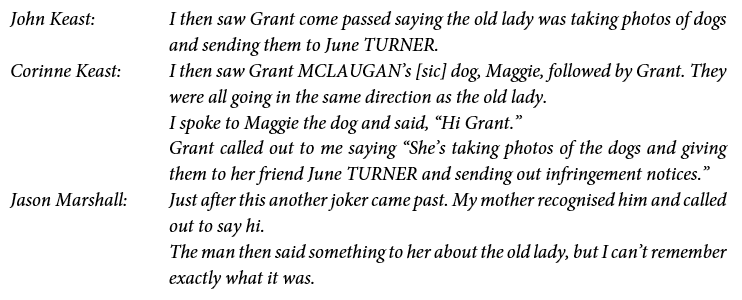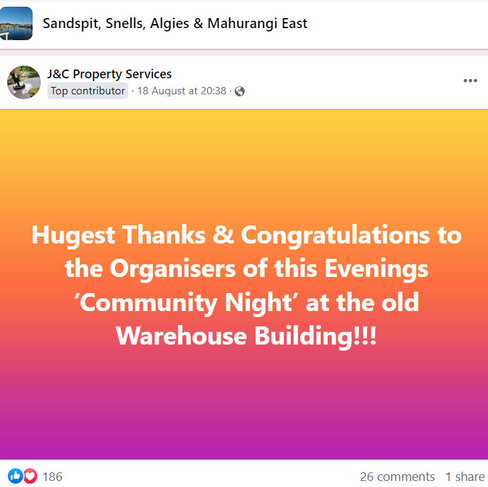R v McLachlan: Who turned the Keasts?
- Grant McLachlan
- Aug 12, 2024
- 11 min read
Updated: Jan 14

Corinne & John Keast.
Source: Facebook
There is a considerable difference between what Corinne and John Keast did, compared to what they said. Why?
Senior police said that their case against me was "compelling" due to the evidence of so many witnesses, especially so-called "independent witnesses" Corinne Keast, her husband John Keast, and son Jason Marshall. The major problem is that what the Keasts and Marshalls did at the crime scene did not reconcile with how they described what they witnessed.
When reading how the three described the incident between Lorraine Martin and I, one question is apparent: Why didn't they intervene? I will answer that question now: What they said happened didn't happen at all.
So why would they lie?
According to their own evidence, there were four sequences of events:
Before Paul Shanahan entered the scene;
While Paul Shanahan was at the scene;
Before they were contacted by Constable Fairbrass; and
Since they were contacted by Constable Fairbrass.
'Said' versus 'did'
There was a pattern in the way that the three acted and then later described what happened:
They encountered something but didn't react;
They would then be told that what they encountered was serious; and
They then described the encounter in a way that was serious.
Take, for instance, their first encounter with Lorraine Martin. Here is how they described it in their police statements:
So, they saw "a little old lady" "rushing" past them and didn't acknowledge her or ask her if she was OK?
Lorraine Martin wasn't in any hurry. Their own evidence said that Lorraine Martin hung around for over five minutes and only left when she saw someone approach to return her camera.
Here is how they described encountering me:
I wasn't in a hurry. I stopped to chat with them. Afterall, their group of five people and two dogs was in this bottleneck and I waited for them to walk through it.
The "bottleneck", looking south.
Corinne Keast then described this in her police statement:
"Dawdling." Again, the group didn't intervene. They continued to walk away.
Here is an aerial photograph of the area:

Five people, two dogs, and a scooter dawdling through that area would have created a bottleneck between the old fence of the Salvation Army camp and the picnic table.
So, Lorraine Martin went through the bottleneck first, then the group "dawdled" through, had a chat with me, and I then went through the bottleneck. If Lorraine Martin "rushed", that would suggest that she had gained a significant distance advantage. But she hadn't.
After passing the group, I thought that Lorraine Martin was long gone. But Lorraine Martin was hiding behind this old gate:
The "bottleneck", looking north.
So, it is now established that the group had dawdled north of the bottleneck. From the park bench to the north of the old fence, they couldn't see the gate from where they were. From behind the gate, Lorraine Martin threw her camera at me, hitting my forehead. I confiscated it, took out my mobile phone, and rang the police. Here is how the three described what happened next:
Four facts are consistent and not disputed:
I told the group that Lorraine Martin had hit me with her camera;
That the group didn't see what initiated the confrontation between Lorraine Martin and I;
I was holding Lorraine Martin's camera in one hand and I was on the phone to police with my other hand; and
That I walked past them and they didn't intervene.
At this point, the group didn't come after me. Instead, the only member of their group who did anything was Corinne Keast:
Basically, no one up to that point thought that anything that I did was worthy of intervention. Furthermore, Corinne Keast believed me when I told them that Lorraine Martin was a vigilante involved in June Turner's posse.
All this changed when Paul Shanahan appeared.
Enter Paul Shanahan
After I left the scene to talk to the Police on my mobile phone, Paul Shanahan appeared from the beach:
Paul Shanahan claimed to have seen me hit Lorraine Martin, chase Lorraine Martin, and he tried to intervene. According to the timestamps on the photographs that I took of Lorraine Martin attacking me and the time that I called the police on my mobile phone, Paul lurked around on the beach for at least three minutes before approaching the group, rather than me or Lorraine Martin.
Paul Shanahan only told the group what he witnessed after hearing the group's version of events. Paul Shanahan claimed that I had attacked Lorraine Martin, to which Lorraine Martin echoed his narrative:
So, Lorraine Martin went from denying being a vigilante one minute to then trying to fit with Paul Shanahan's story by lowering her mask to show bruising that she knew was already there. Furthermore, her mood suddenly became "distraught."
In their police statements drafted a week later, the witnesses recalled things that simply weren't there. The mark was not red. It wasn't a 'shiner.' Photos taken only an hour after the incident don't support this. Lorraine Martin had discolouration that wasn't fresh but was at least a week old.
Immediately following the incident, Paul Shanahan and Lorraine Martin claimed that they exchanged details with each other. The Keasts and Marshalls didn't mention witnessing that exchange, neither did Shanahan and Martin exchange details with the Keasts or Marshalls. Why?
What Paul Shanahan told the group was a lie. He had motive to lie and he had an opportunity for revenge. I cover this in a separate article. In short, take Paul Shanahan out of the equation and none of what followed would have happened.
Without going into detail, Paul Shanahan spent over five minutes with the group. Paul Shanahan must have convinced Corinne Keast to do this:
Despite knowing that I was on the phone to Police and describing the camera to the police officer while on speaker, this happened:
Corinne Keast was now so convinced by Paul Shanahan's narrative, she interrupted a phone call with a police officer and thought that returning a camera (which was evidence) to Lorraine Martin was a good idea. Nothing I said mattered to her.
(And how could I be deleting photos on a camera that Lorraine Martin said was "inoperable" beyond repair and Constable Fairbrass said had flat batteries?)
If Corinne Keast wanted to hold on to the camera and hold it as evidence, that would have been the right thing to do. Instead, there were two attempts - by Corinne Keast and her grandson - to return the camera to Lorraine Martin. Lorraine, however, waved her hands around and refused to accept it.
What Corinne Keast tried to do was suppress evidence from me that I could have used to support my police complaint. She was now an accessory after the fact, which is a crime:

After I ended the call, I headed south, passing the group assembled, albeit missing Lorraine Martin and the grandson. When I told the group what had happened, Corinne Keast's son, Jason Marshall, claimed that his mother did this:
Corinne Keast now went from the point of following Paul Shanahan's narrative to adding lies to reinforce Shanahan's lies. She had joined a conspiracy to bring a false accusation and interfered with evidence that could have proven that their accusations against me were false.
When Lorraine Martin left the group to head to Diane Taylor's home, Paul Shanahan didn't accompany her. Instead, he leaned smugly behind the old gate, refusing to tell me his name or what he claimed to have seen. He was making sure that the Keasts and Marshalls kept to his narrative.
I had photographed Lorraine Martin attack me. I told the group that Lorraine Martin had attacked me twice and they believed it before Paul Shanahan approached the group. After Paul Shanahan spent five minutes with the group, that had all changed. I then tried to show the photographs to Corinne. Instead, Jason Marshall claimed this happened:

Think about how ridiculous that sounds. Jason Marshall is much bigger and stronger than me. Prior to that point, he never intervened nor did anything that indicated that he thought that I was a risk to anyone.
More importantly, Jason Marshall and Corinne Keast both admit that they didn't want to hear nor see evidence supporting my version of events and then physically suppressed evidence from being shared.
I then left the group to head home. Paul Shanahan, who claimed to have exchanged details with Lorraine Martin, didn't offer to hold on to the camera and return the camera to Lorraine Martin later. Instead, he let John Keast do this:
Read that again. John Keast not only offered a camera to another vigilante but that vigilante accepted it, claiming to not know the vigilante. At the very least, that would suggest that he believed one aspect of what I said but didn't want anything more to do with the camera - or the incident.
More importantly, the Keasts and Marshalls had passed the threshold of being passive bystanders who claimed to have witnessed an alleged crime. They now actively suppressed evidence that I said was used as a weapon, handing it to someone who could have tampered with it.
The Keasts and Marshalls didn't contact the police. Instead, Constable Fairbrass contacted John Keast a week later.
Why?
Who are the Keasts?
It is important to jump in here and provide a bit of background about who Corinne and John Keast are and how I know them. I met them in early August 2021. The incident on 18 September 2021 was the seventh time that we'd met. I remember this number because Tony Robinson and I met the couple on three occasions, the only time that they weren't with Tim Rowsell was 17 September 2021, and I had forgotten Corinne's name on the third occasion that we'd met. The way I remembered John Keast's name was because Tony described him as "looking like an unmade bed."
Tim Rowsell was Diane Taylor's neighbour for several months in 2021, living next to the boatramp. He then moved into an apartment at Whisper Cove, overlooking the northern end of Snells Beach. On 18 September 2021, it was Tim Rowsell who tried to lure me away behind Bayside Café while Lorraine Martin interfered with Maggie leashed to a fence.
Tim Rowsell introduced me to the Keasts. All the times that I met the couple was on the footpath between Ariki Drive and the boatramp. I warned them to not walk north of the boatramp because of June Turner. I'd later discover that June Turner was a member of their congregation. Corinne and John were very religious:
Source: Facebook
Tim Rowsell and Corinne Keast had "gone down the rabbit hole" during the lockdowns, describing conspiracy theories about Covid. They were self-described "anti-vaxxers."
They also held strong political views:
And, Corinne held strong views about the police:
John Keast was some type of male nurse but then started his own cleaning business with his wife. To raise their profile for their new venture, they endorsed others. Here are two examples:
On 18 September 2021, Auckland was enduring its fourth Covid-19 Alert Level Four lockdown. Corinne and John Keast aimed to walk their two dogs along the full length of the Snells Beach esplanade. Joining them was her son, Jason Marshall, his heavily pregnant wife, and her eight-year-old grandson pushing his scooter. The Keasts lived on the other side of Snells Beach, next to Goodall Reserve. The Marshalls, however, had travelled all the way from Wellsford - in obvious breach of the lockdown rules. Furthermore, the Keasts and Marshalls weren't in the same "bubble", weren't wearing masks, nor were they social distancing.
Lorraine Martin and Paul Shanahan wore masks as disguises, criticising me for not wearing a mask or social distancing. Wouldn't it be an embarrassing situation to address if it came to light that in fact all the witnesses had breached the Covid lockdown rules?
Enter Constable Fairbrass
According to Constable Fairbrass' notebook and emails, she drafted Lorraine Martin's and Paul Shanahan's statements and emailed the drafts to them shortly after Fairbrass talked to me on the phone. A week later, Fairbrass rang Lorraine Martin and Paul Shanahan before contacting the Keasts:
Obviously, the two draft statements weren't enough and the Keast's evidence was necessary to bolster the evidence that Fairbrass had already gathered. Fairbrass needed more 'independent' witnesses to verify what Lorraine Martin and Paul Shanahan claimed they witnessed.
Fairbrass visited Corinne Keast at 11:45am but took statements from both her and her husband within a minute of each other. In other words, they were the only witnesses who both spoke to Fairbrass at the same time, meaning that they both gave their statements at the same time to a police officer. The toing and froing would have been like a brainstorming session, where one fed answers to the others, adding details like a contest of ideas.
Somewhere along the line, the Keasts agreed to say this:
This was obviously a lie. Can you imagine the married couple sitting next to each other on a couch as Fairbrass spurred them on?
None of this happened. What they said they saw completely contradicted what they did. Who would believe that a group of people would watch a man violently shake a little old lady for over a minute and their only intervention was saying "Steady on Grant!" and then continue to have a conversation with Lorraine Martin and I while they claimed that I was shaking her?
Think about how over one minute of violence fits with the undisputable timeline of events. There was 3 minutes and 3 seconds between the last photo that I took of Lorraine Martin attacking me and when I rang the police. If Paul Shanahan claimed to have seen me "round house" Lorraine Martin in the head, that means that he stood around, watch me attack Lorraine Martin a second time without raising concern, and then approach the group after I left the area talking on my phone. Furthermore, here are the least number of things that I needed to do in that three minutes:
Return to my dog and untie her from the fence;
Chat with Tim Rowsell to explain what had just happened, who pointed out the Keasts approaching;
Walk one hundred metres with a dog towards the bottleneck;
Wait for the Keasts to "dawdle" through the 20 metre long bottleneck;
Warn Corinne Keast about Lorraine Martin and explain to her what had just happened;
Walk past the Keasts;
Get a camera off Lorraine Martin; and
Then get out my phone, find the number of a police officer on my phone, and then call them.
What is even more bizarre is that Jason Marshall, who is much bigger and stronger than I, said even more exaggerated things in his statement:
Fairbrass visited Paul Shanahan after she took the Keast's statements and then added five paragraphs to Paul Shanahan's statement that appeared as though they were copy-and-pasted from the Keasts' statements. It mustn't have occurred to Fairbrass at the time that Shanahan wouldn't have been able to witness those events because the Keasts and the Marshalls said in their statements that Shanahan appeared on the scene later.
The Keasts really dug a hole for themselves. At the trial, they kept digging - contradicting their own police statements. Take, for instance, when the three all said in their police statements that Corinne Keast greeted me and I warned her about Lorraine Martin. During cross examination, she instead said this:
Or what about when others said in their police statements that Corinne didn't see what started the altercation between Lorraine Martin and she accused Lorraine Martin of getting herself into trouble? During cross examination, Corinne came up with this:
It was like they forgot what they said in their police statement and came up with a completely new version of events. Were they just providing answers to get me locked away, behaving like a recalcitrant dog disingenuously trying to please an intimidating master?
The unavoidable truth is that the Keasts changed their positions twice and those changes were in direct response to contact with Paul Shanahan and Constable Jacqueline Fairbrass.
By trying to support a false narrative to get me locked away, they committed crimes where the punishments were harsher.

These are just some examples of the many questionable motives in my book Unleashed: Sex, rackets & vigilantes in New Zealand's most corrupted community.





















































